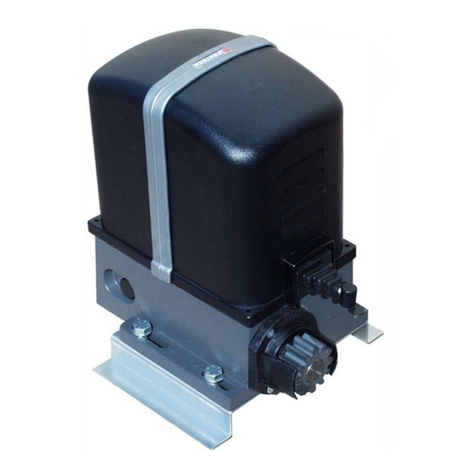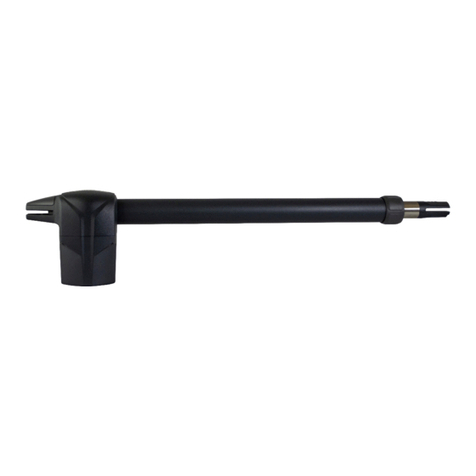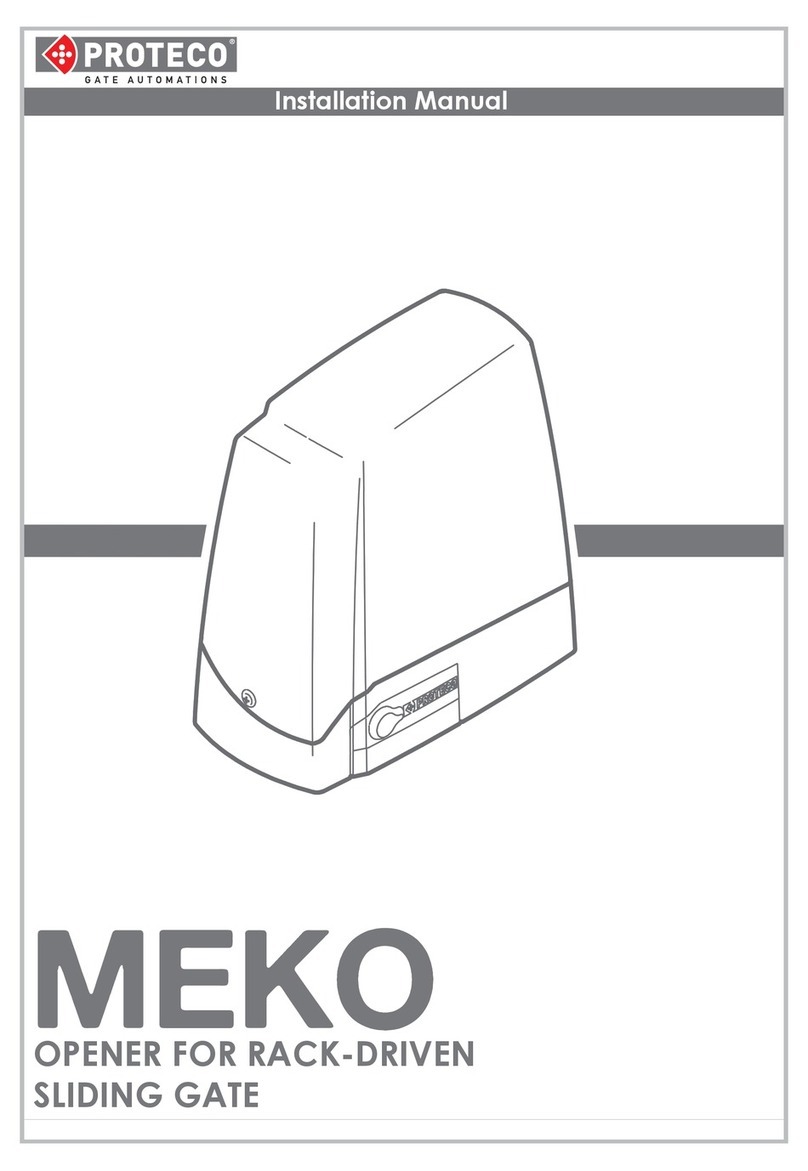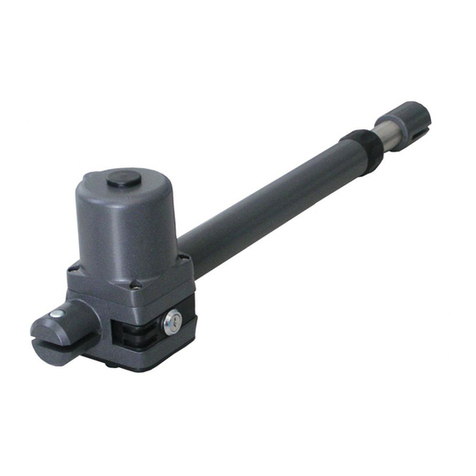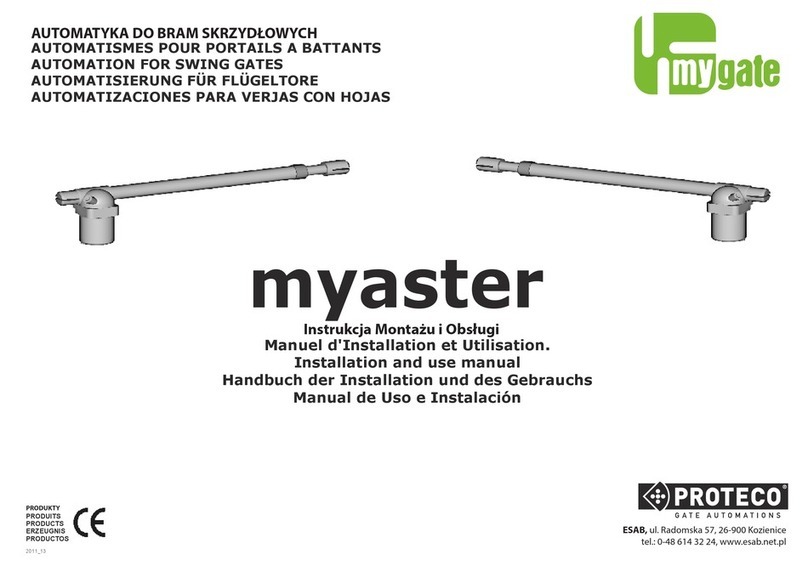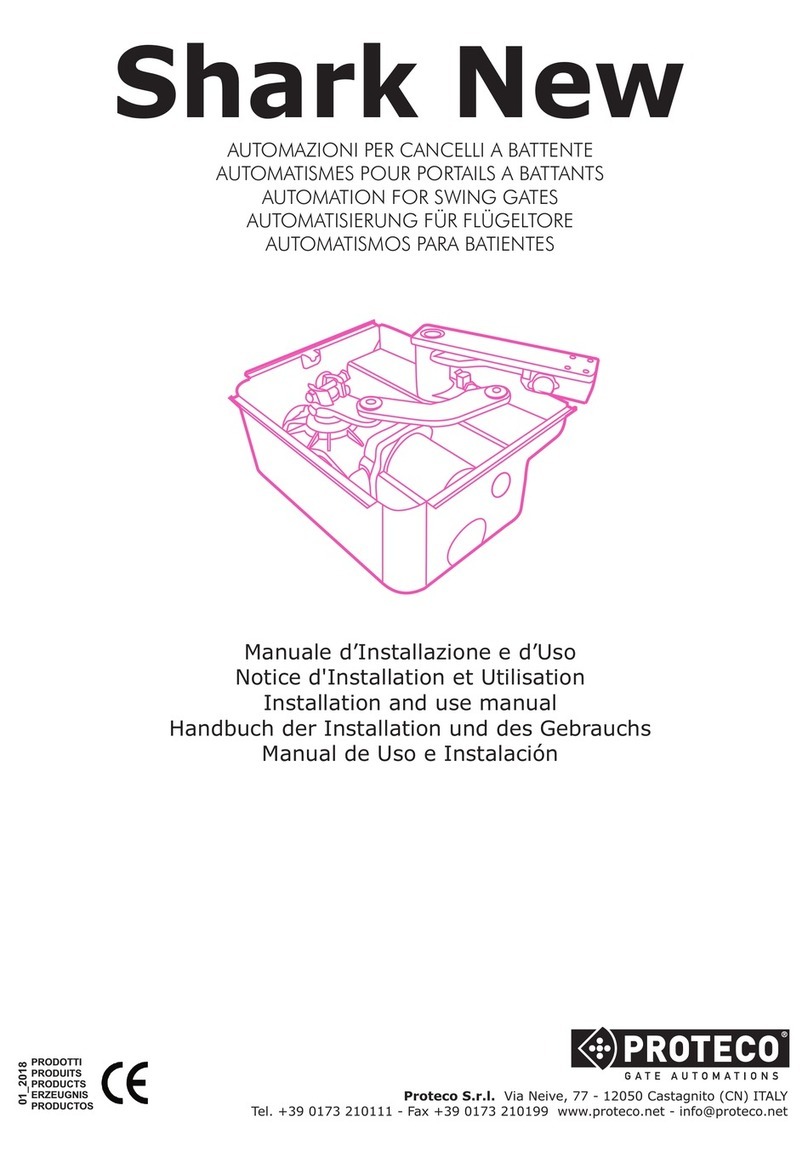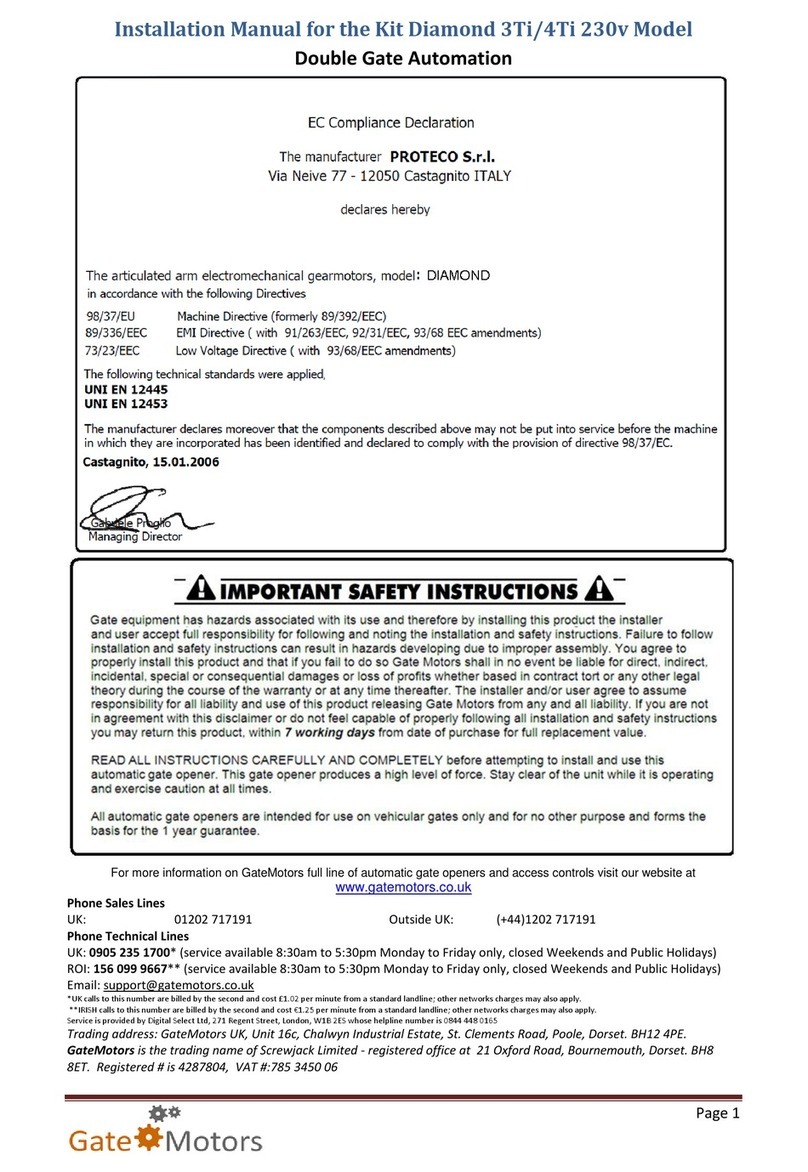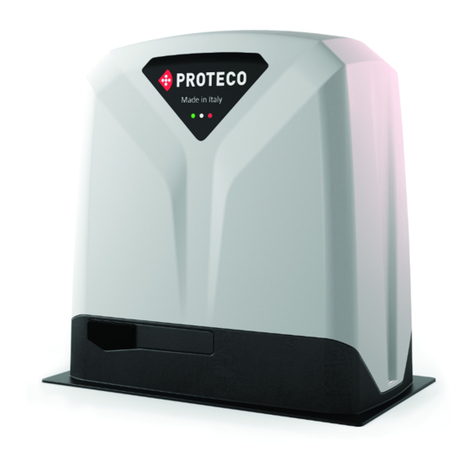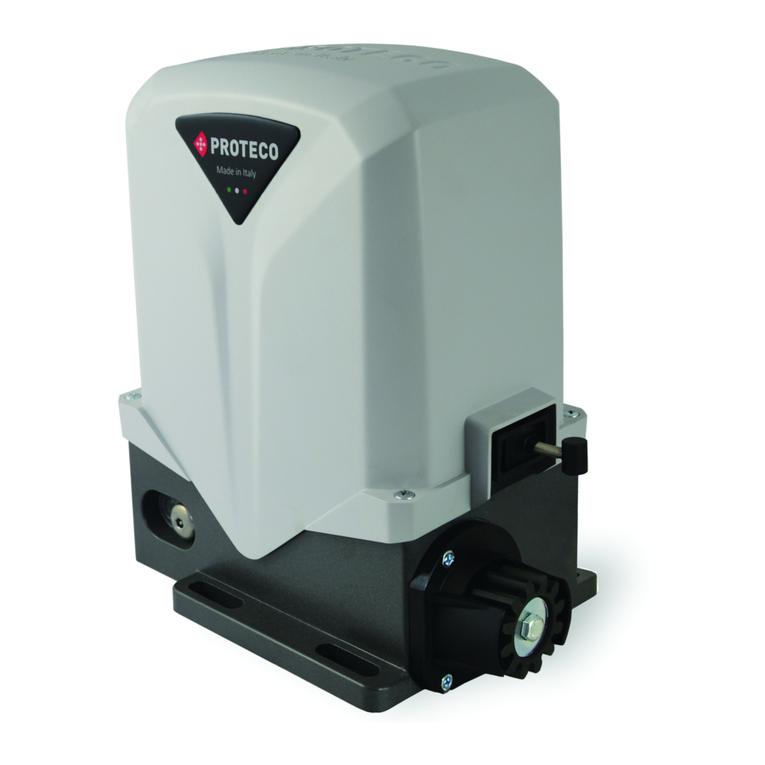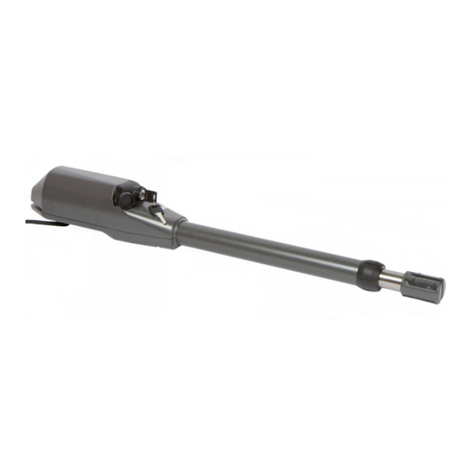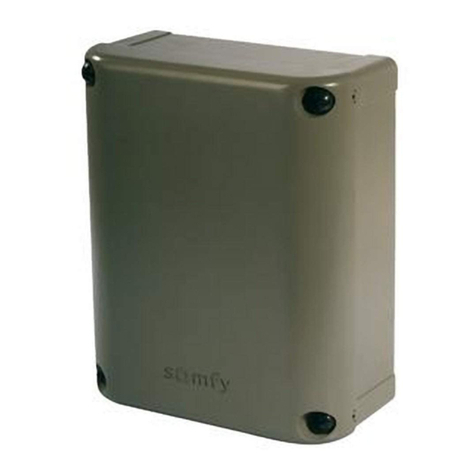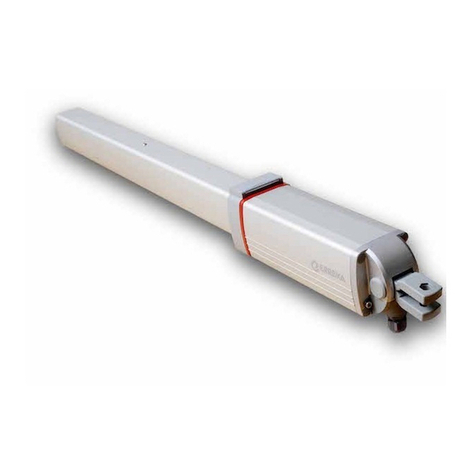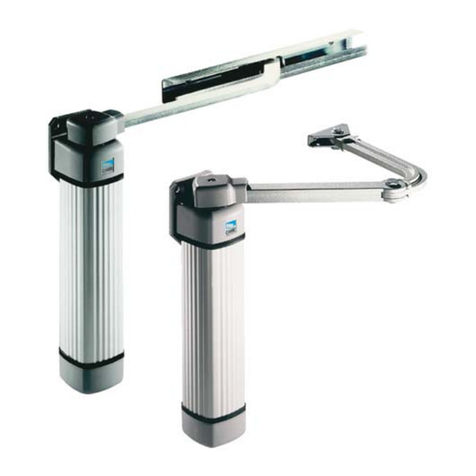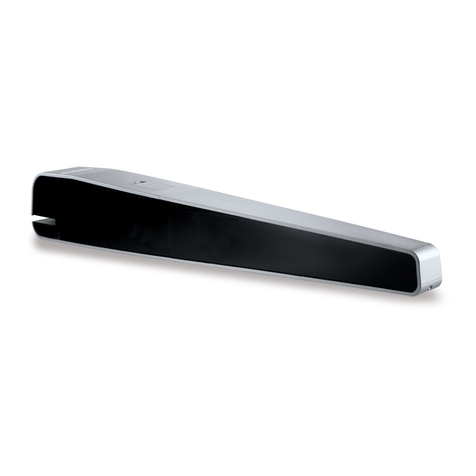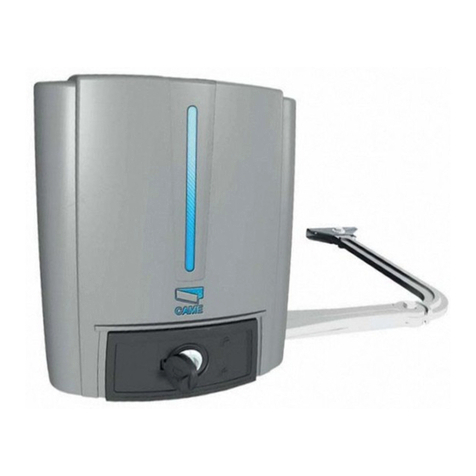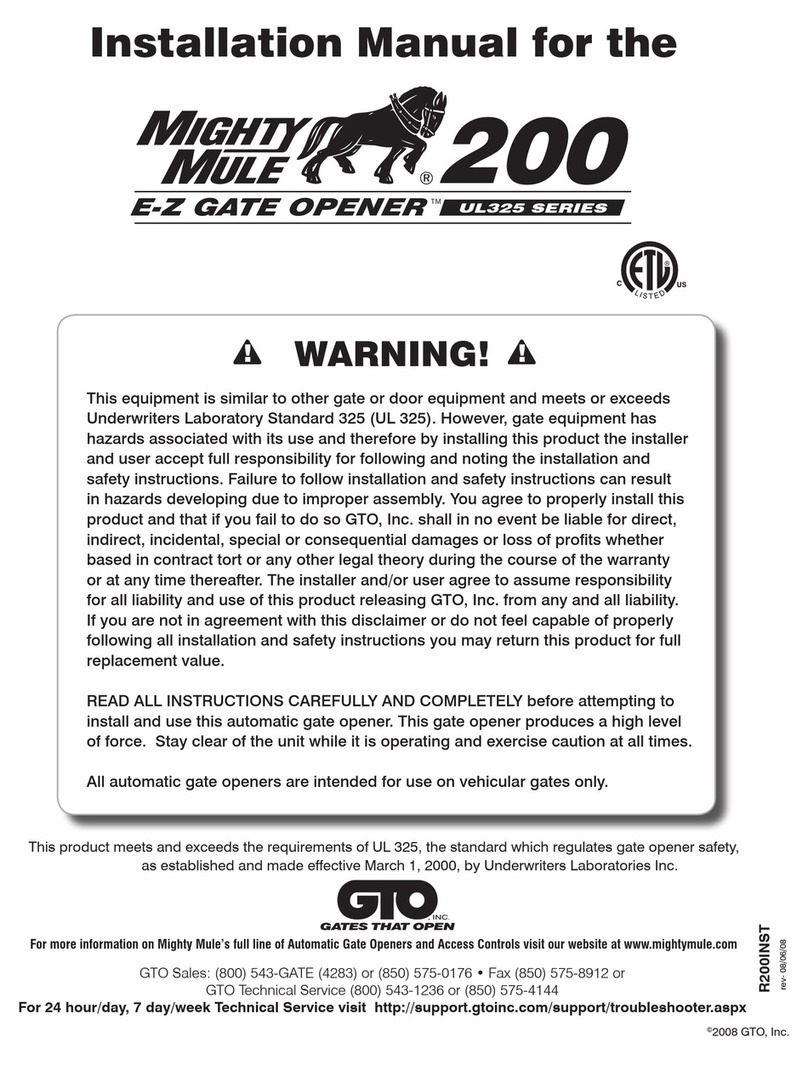
CRITERI DI SICUREZZA
1Prima di iniziare qualsiasi operazione di installazione è assolutamente
necessario leggere tutto il presente manuale.
2 Vericarecheleprestazionidell’attuatoreacquistatocorrispondano
alle vostre esigenze d’ installazione.
3 Inoltrevericareche:
- Le cerniere del cancello siano in buono stato e perfettamente
ingrassate.
- Il cancello sia dotato di fermi meccanici in apertura ed in chiusura.
CONSIGLI PER L’INSTALLAZIONE
Collegamenti:
• Vedere “Schema funzionale” e fare riferimento agli schemi dalla
centrale di comando.
• Il cavo elettrico in uscita dall’attuatore non deve essere teso,
ma fare un’ampia curva verso il basso onde evitare il riflusso di
acqua all’interno dell’attuatore stesso. (Fig. Q)
• Tutti i collegamenti devono essere effettuati in assenza di
alimentazione.
• Prevedere un dispositivo di sezionamento onnipolare nelle vicinanze
dell’apparecchio (i contatti devono essere di almeno 3 mm).
Proteggere sempre l’alimentazione per mezzo di un interruttore
automatico da 6A, oppure per mezzo di un interruttore monofase
da 16A completo di fusibili.
• Le linee di alimentazione ai motori, alla centrale e le linee di
collegamento agli accessori devono essere separate onde
evitare disturbi che potrebbero generare mal funzionamenti
dell’impianto.
• Qualsiasi apparecchiatura (di comando o sicurezza) eventualmente
asservita alla centrale deve essere libera da tensione (contatti
puliti).
Parti di ricambio:
• Utilizzare solamente parti di ricambio originali.
• Noneliminarelebatterieconiriutiurbanimasmaltirlecome
riutiindustriali(Leggen°475/88).
Modalità di installazione:
• Per un uso proprio del prodotto e per escludere ogni possibilità
di danneggiamenti a persone, animali o cose, fare riferimento al
foglio “Generalità” allegato che fa parte integrante del presente
manuale.
• L’impiego di questa apparecchiatura deve rispettare le norme
di sicurezza vigenti nel paese di installazione oltre alle norme
di buona installazione.
• In allegato alle presenti istruzioni troverete un adesivo (indicativo
del nome prodotto e produttore) da apporre in un punto visibile
del prodotto.
Garanzia:
• La garanzia fornita dal costruttore decade in caso di manomissione,
incuria, uso improprio, fulmini, sovratensioni o utilizzo da parte
dipersonalenonprofessionalmentequalicato.
• Fainoltredecaderequalsiasidirittoallagaranzia:nonrispettare
le istruzioni riportate sui manuali allegati ai prodotti, l’applicazione
anche di un solo particolare in modo non rispondente alla
legislazione vigente o l’utilizzo di parti di ricambio non congeniali
e/ononespressamenteapprovatedalladittacostruttrice.
• Il costruttore non può considerarsi responsabile per eventuali
danni causati da usi impropri ed irragionevoli.
SEQUENZA DI INSTALLAZIONE
1Prima di iniziare la messa in opera, effettuare sull’installazione
l’analisi dei rischi facendo riferimento al foglio “Generalità” che
fa parte integrante del presente manuale, riempire le tabella
tecnica ed eliminare i rischi rilevati.
Nel caso in cui vi siano rischi residui, prevedere l’installazione
con sistemi di sicurezza a completamento.
2 Vericarelenormedisicurezzacitatenei“CRITERIDISICUREZZA”.
3 Identicarel’attuatoredestroel’attuatoresinistro.
4 Vericaretuttiicomponenti.
5 Identicareilpuntodiancoraggiosulcancelloediconseguenza
sul pilastrino.
6Fissare la piastra di ancoraggio sul pilastrino.
7Fissare il motore sulla piastra di ancoraggio.
8Sbloccare l’attuatore
9Posizionare il braccio articolato.
10 Fissare la staffa S3 sul cancello.
11 Stendere i cavi come da “Schema funzionale”.
12 Collegare centrale e tutti gli accessori
13 Programmare il ricevitore radio.
14 Eseguire la programmazione dei “Tempi di funzionamento”.
In caso di mal funzionamento, fare riferimento alla tabella “Anomalie
e consigli”.
Nel caso in cui non riusciate a trovare alcuna soluzione telefonare
al più vicino centro di assistenza.
ELETTRO SERRATURA
L’elettroserratura deve essere installata sull’anta che si apre per
prima e deve essere collegata ai relativi morsetti della centrale.
Posizionedell’elettroserratura:(Fig.B)
Posizione 1:Scroccodichiusuranellabattuta
(inquestocasoènecessarioutilizzareilpalettomodelloRT15sulla
seconda anta).
Posizione 2:Scroccodichiusuraapavimento.
(in questa posizione l’utilizzo del paletto non è indispensabile)
Ricordarsidieliminarelaserraturaoquantomenorenderlainattiva
bloccando lo scrocco in posizione aperta ed eliminare tutti i paletti
di chiusura.
ATTUATORE DESTRO O SINISTRO (Fig. A)
Gli attuatori sono forniti in versione destra e sinistra.
PerstabiliresesinecessitadiunattuatoreDestrooSinistroguardare
il cancello dal lato in cui è installato l’attuatore, se le cerniere sono
sulla destra l’attuatore è destro, se sono sulla sinistra l’attuatore è
sinistro.
Diconseguenzal’attuatoredovràessereinstallatoconilpernodi
uscita posizionato verso le cerniere de cancello.
DETERMINAZIONE QUOTE DI FISSAGGIO
Perdeterminareilpuntodiancoraggioèbenetenerepresente:
• A = 300 mm (Fig. C)
Dimensionemax.tral’assedelcancelloelospigolodelpilastrino.
• B = 30 mm (Fig. C)
Dimensioneminimadallapiastradiancoraggioallospigolodel
pilastrino. (per evitare la possibile rottura dello spigolo)
• D = 14 mm (Fig. F)
Distanzaverticaledall’asseorizzontaledellastaffaS3sulcancello
(puntodiancoraggio),alloinferioredellapiastradiancoraggio
sul pilastrino.
Cancello ssato al centro del piastrino (Fig. D)
Inquestocasol’angolomax.diaperturadelcancelloèdi90°.
Cancello ssato sullo spigolo del pilastrino (Fig. E)
Inquestocasoilcancellopuòaprireconunangolomaggioredi90°.
Tenere presente che aumentando la distanza dall’attuatore allo spigolo
del pilastrino misura B, aumenta l’angolo di apertura del cancello.
ALTEZZA DI FISSAGGIO (Fig. G)
Determinare l’altezza di ssaggio dell’attuatore in funzione dalla
formadelcancelloedallepossibilitàdissaggiosudiesso.
a) Se la struttura del cancello è robusta si può posizionare a qualsiasi
altezza senza limitazioni.
b) Se la struttura è leggera occorre tenere l’attuatore più vicino
possibile alla mezzeria del cancello (in altezza).
Posizione 1 Traversa centrale del cancello
Posizione 2 Rinforzodelcancello.
FISSAGGIO DELLA PIASTRA DI ANCORAGGIO
Tassellare o saldare sul pilastrino a lato del cancello la piastra di
ancoraggio tenendo presente le quote sopra indicate.
Nelcasodissaggiopermezzoditasselliadespansioneutilizzare
tasselli metallici Ø 13 mm e tenere presente che il tassello deve
essereposizionatoanonmenodi30÷35mm.dallospigolodel
pilastrino per evitare la possibile rottura di esso.
Nel caso di pilastrini in muratura utilizzare tasselli chimici o in resina
oppure una staffa opportunamente murata.
E’ possibile utilizzare la piastra posizionandola in due diversi modi,
sia per l’attuatore destro che per il sinistro, a seconda delle esigenze.
(Fig.H/I)
IT
5
Advantage - rev. 14_06_2022


